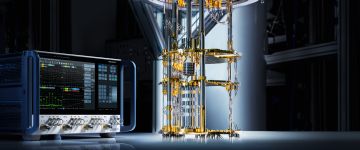Controlling quantum states with microwave signals
The energy state of a qubit can be controlled with external microwave signals. A Bloch sphere illustrates this process (Figure, right). The one and zero logic states are located at the north and south poles of the Bloch sphere. Every other point on the surface of the sphere corresponds to a superposition state. The current state is indicated by the so-called state vector. Interaction with a resonant microwave signal causes rotation of the state vector in the Bloch sphere.
To perform dependable computing operations with qubits, this rotation needs to be controlled with great precision based on the pulse length, microwave signal amplitude and the control pulse envelope. The so-called relative phase of the control pulse influences the rotation axis of the qubit state in the Bloch sphere. When pulses with the same phase are applied to the qubit, the state always rotates on e.g. the x-axis. If a pulse is phase-shifted by 90°, the state vector will rotate on the y-axis.
Signal source requirements
Arbitrary waveform generators are reliable, flexible control signal sources. Together with microwave sources and mixers, the right pulses can be generated at the right qubit frequency. By precisely regulating the control pulse phase in real time and exact control of the envelopes, any desired target point on a Bloch sphere can be reached at any time from any starting point.
Unlike conventional computing operations with a high error tolerance, quantum computers rely on precise calibration of control pulses. Even tiny deviations in the rotation (over rotation of the quantum state by 1 %) can alter the resulting quantum operation. Similar errors occur with inaccurate phase control. Control instruments for quantum computers must therefore have high phase and amplitude stability. Control pulse phases are regulated by the in-phase and quadrature components of the pulse stored on the arbitrary waveform generator.










